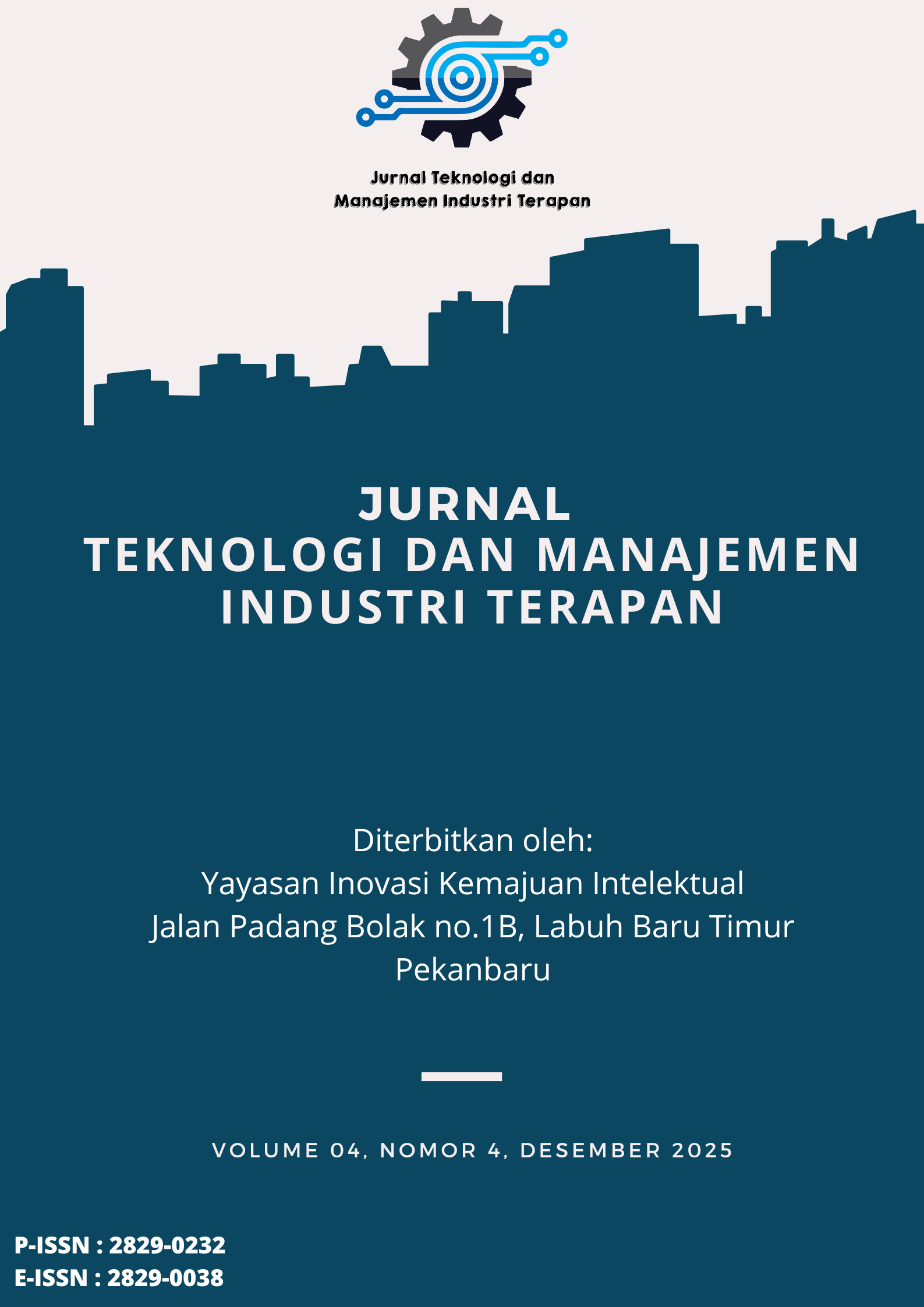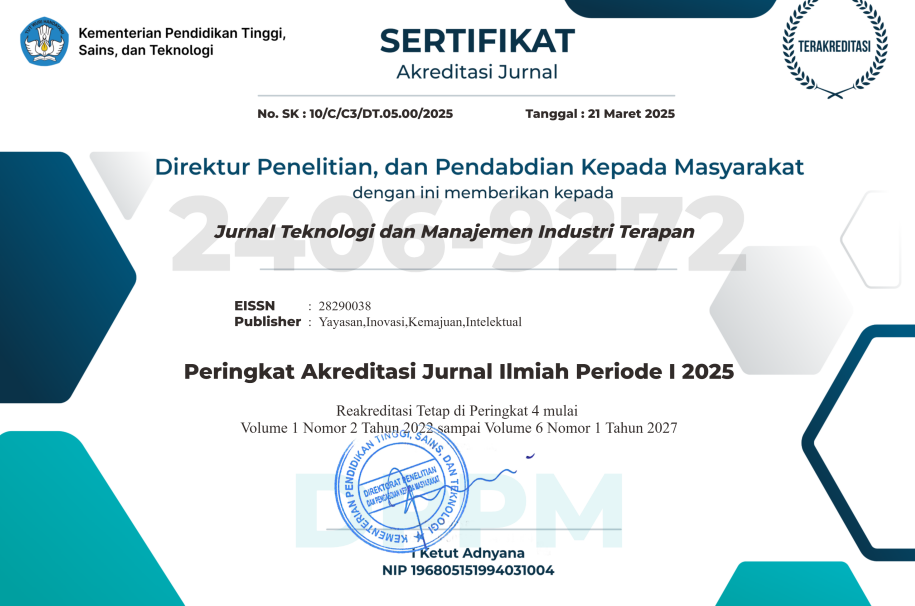Pengembangan Sistem Penyaringan Air Berbasis Energi Surya
DOI:
https://doi.org/10.55826/jtmit.v4i4.1250Keywords:
Energi Surya, Filtrasi Air, Biji Kelor, Zeolit, Air BersihAbstract
Penelitian ini mengembangkan sistem penyaringan air berbasis energi surya dengan pendekatan inovatif menggunakan kombinasi bahan filtrasi alami yang ramah lingkungan. Kebaruan penelitian ini terletak pada integrasi sistem filtrasi bertingkat dengan pemanfaatan kolektor surya sebagai penguat proses pemurnian air berkekeruhan tinggi yang sulit dijernihkan. Tujuan penelitian adalah menghasilkan sistem penyaringan air portabel yang efektif dalam menurunkan tingkat kekeruhan dan kontaminan mikrobiologis, sesuai standar air bersih Kementerian Kesehatan. Metode penelitian dilakukan secara eksperimental di Laboratorium BLKK Las dan Dinas Kesehatan Kabupaten Sorong Selatan, dengan pengujian parameter fisik, kimia, dan mikrobiologi sebelum dan sesudah proses filtrasi. Sistem terdiri atas dua tabung penyaringan yang diisi dengan kombinasi kerikil, serbuk biji kelor, zeolit, arang aktif, dan biokeramik, serta dilengkapi kolektor surya berbahan aluminium dan kaca transparan untuk meningkatkan suhu air sebesar 10–13°C. Hasil penelitian menunjukkan bahwa sistem mampu menurunkan kekeruhan air secara signifikan, meningkatkan pH menjadi netral (7,0), serta menurunkan kadar bakteri E. coli dari 420 menjadi 15 CFU/100 mL. Implikasi praktis dari penelitian ini adalah terciptanya teknologi filtrasi portabel berbasis energi surya yang mampu menjernihkan air sangat keruh sekaligus menghilangkan kontaminan biologis, sehingga dapat diterapkan pada wilayah dengan keterbatasan pasokan air bersih.
References
[1] I. Hanafi and K. Hariyanto, “Perancangan Alat Pemanas Air Tenaga Surya Dengan Metode Kansei Engineering,” J. Syst. Eng. Technol. Innov., vol. 1, no. 01, pp. 19–24, 2022, doi: 10.38156/jisti.v1i01.12.
[2] H. Ambarita, F. Siahaan, H. -, and H. . Sihombing, “Performansi Pemanas Air Tenaga Surya Dengan Penambahan Sirip Pada Pipa Kolektor,” Sprocket J. Mech. Eng., vol. 1, no. 2, pp. 57–64, 2020, doi: 10.36655/sprocket.v1i2.180.
[3] M. F. Ahmed, M. Bin Mokhtar, and N. A. Majid, “Household water filtration technology to ensure safe drinking water supply in the Langat river basin, Malaysia,” Water (Switzerland), vol. 13, no. 8, pp. 25–27, 2021, doi: 10.3390/w13081032.
[4] B. Ahmad, S. Hi. Umar, and M. Taufiq Y.S, “Analisis Sistem Penyaringan Air Bersih Pada Air Sumur Warga Di Kelurahan Fitu Kota Ternate Selatan,” J. Sci. Eng., vol. 6, no. 1, pp. 16–21, 2023, doi: 10.33387/josae.v6i1.6100.
[5] J. Satpute et al., “Performance optimization for solar photovoltaic thermal system with spiral rectangular absorber using Taguchi method,” Sci. Rep., vol. 14, no. 1, pp. 1–13, 2024, doi: 10.1038/s41598-024-73065-9.
[6] V. S. Vigneswaran et al., “Energy, Exergy, and Economic analysis of low thermal conductivity basin solar still integrated with Phase Change Material for energy storage,” J. Energy Storage, vol. 34, p. 102194, 2021, doi: https://doi.org/10.1016/j.est.2020.102194.
[7] A. R. Pakku and J. La’lang, “Rancang Bangun Pemanas Air Kontinu Sistem Hybrid Tenaga Surya Dan Gas,” 2022.
[8] G. Setyono, N. Kholili, and Y. Rakhmadanu, “The Impact of Utilization The Solar-Panels With a Cooling-Water System as a Source of Micro-Power Generation,” Infotekmesin, vol. 13, no. 1, pp. 87–92, 2022, doi: 10.35970/infotekmesin.v13i1.1001.
[9] S. K. Vishnu and R. Senthil, “Experimental performance and economic analysis of finned solar receiver for parabolic dish solar collector,” Heliyon, vol. 9, no. 11, p. e21236, 2023, doi: 10.1016/j.heliyon.2023.e21236.
[10] P. Y. Lestari et al., “Solar Panel Solar Panel Installation Battery Testing SLiMS Installations mySQL Installation Apache Installation,” vol. 02, no. 02, pp. 7–14, 2022.
[11] G. J. Ji, J. M. Gu, Z. Chen, B. B. Lu, and Y. Gao, “Experimental research on heat transfer characteristic of HITEC molten salt in evacuated tube solar collector,” Front. Energy Res., vol. 11, no. May, pp. 1–10, 2023, doi: 10.3389/fenrg.2023.1150326.
[12] C. Zhang, N. Li, and G. An, “Review of Concentrated Solar Power Technology Applications in Photocatalytic Water Purification and Energy Conversion: Overview, Challenges and Future Directions,” Energies, vol. 17, no. 2, 2024, doi: 10.3390/en17020463.
[13] B. E. Cowie, V. Porley, and N. Robertson, “Solar Disinfection (SODIS) Provides a Much Underexploited Opportunity for Researchers in Photocatalytic Water Treatment (PWT),” ACS Catal., vol. 10, no. 20, pp. 11779–11782, 2020, doi: 10.1021/acscatal.0c03325.
[14] T. T. Ross, M. A. Alim, and A. Rahman, “Simple and effective filtration system for drinking water production from harvested rainwater in rural areas,” J. Environ. Manage., vol. 373, no. May 2024, p. 123887, 2025, doi: 10.1016/j.jenvman.2024.123887.
[15] M. E. H. Attia, A. E. Kabeel, M. Abdelgaied, F. A. Essa, and Z. M. Omara, “Enhancement of hemispherical solar still productivity using iron, zinc and copper trays,” Sol. Energy, vol. 216, pp. 295–302, 2021, doi: https://doi.org/10.1016/j.solener.2021.01.038.
[16] T. T. Hlaing, K. T. T. Htwe, and K. M. M. Htike, “A Study of The Some Physicochemical Properties of Water Sample from Ngamoeyeik Creek near North Okkalapa Township and Treated with Moringa oleifera L,” Dant-Da-Lun) Seed. 3rd Myanmar Korea Conf. Res. J, vol. 3, no. 5, pp. 1937–1943, 2020.
[17] T. A. Adesakin et al., “Assessment of bacteriological quality and physico-chemical parameters of domestic water sources in Samaru community, Zaria, Northwest Nigeria,” Heliyon, vol. 6, no. 8, p. e04773, 2020, doi: 10.1016/j.heliyon.2020.e04773.
[18] T. C. Shan, M. Al Matar, E. A. Makky, and E. N. Ali, “The use of Moringa oleifera seed as a natural coagulant for wastewater treatment and heavy metals removal,” Appl. Water Sci., vol. 7, no. 3, pp. 1369–1376, 2017, doi: 10.1007/s13201-016-0499-8.
[19] Z. Zhu, “Experimental study of the rheology of water-kaolinite suspensions,” Water Supply, vol. 22, no. 2, pp. 1781–1795, 2022, doi: 10.2166/ws.2021.319.
[20] V. V. F. Rocha, I. F. S. dos Santos, A. M. L. Silva, D. O. Sant’Anna, A. L. Junho, and R. M. Barros, “Clarification of high-turbidity waters: a comparison of Moringa oleifera and virgin and recovered aluminum sulfate-based coagulants,” Environ. Dev. Sustain., vol. 22, no. 5, pp. 4551–4562, 2020, doi: 10.1007/s10668-019-00397-2.
[21] J. Rammal et al., “Comparative Analysis of Natural and Synthetic Materials for Wastewater Treatment: Plant Powders, Activated Carbon, Biochar, Zeolite, and Nanomaterials,” J. Chem. Rev, vol. 7, no. 4, pp. 566–590, 2025.
[22] A. E. Ahizi et al., “Optimization of Moringa oleifera cationic protein/zeolite adsorbent blend for synthetic turbid water treatment,” Sustain. Water Resour. Manag., vol. 9, no. 1, 2023, doi: 10.1007/s40899-022-00780-4.
[23] N. Al-Jadabi, M. Laaouan, S. El Hajjaji, J. Mabrouki, M. Benbouzid, and D. Dhiba, “The Dual Performance of Moringa Oleifera Seeds as Eco-Friendly Natural Coagulant and as an Antimicrobial for Wastewater Treatment: A Review,” Sustain., vol. 15, no. 5, pp. 1–37, 2023, doi: 10.3390/su15054280.
[24] K. Sembiring, “Perbaikan Parameter Kualitas Air Menggunakan Biji Kelor dan Zeolit Teraktivasi pada Prototipe Filter Air Payau Sederhana Improvement of Water Quality Parameters Using Moringa Seeds ...,” Airaha, no. June, 2024, doi: 10.15578/ja.v13i01.657.
[25] L. N. Azizah Azzahra and A. Imam Santoso, “Sistem Pengolahan Air Gambut Menjadi Air Bersih Dengan Menggunakan Alat Penjernih Air,” J. Tek. SILITEK, vol. 3, no. 01, pp. 18–22, 2023, doi: 10.51135/jts.v3i01.56.
Downloads
Published
Issue
Section
License
Copyright (c) 2025 Rosa orpa Sapulette, Atus Buku, Corvis L Rantererung

This work is licensed under a Creative Commons Attribution-NonCommercial-ShareAlike 4.0 International License.


















